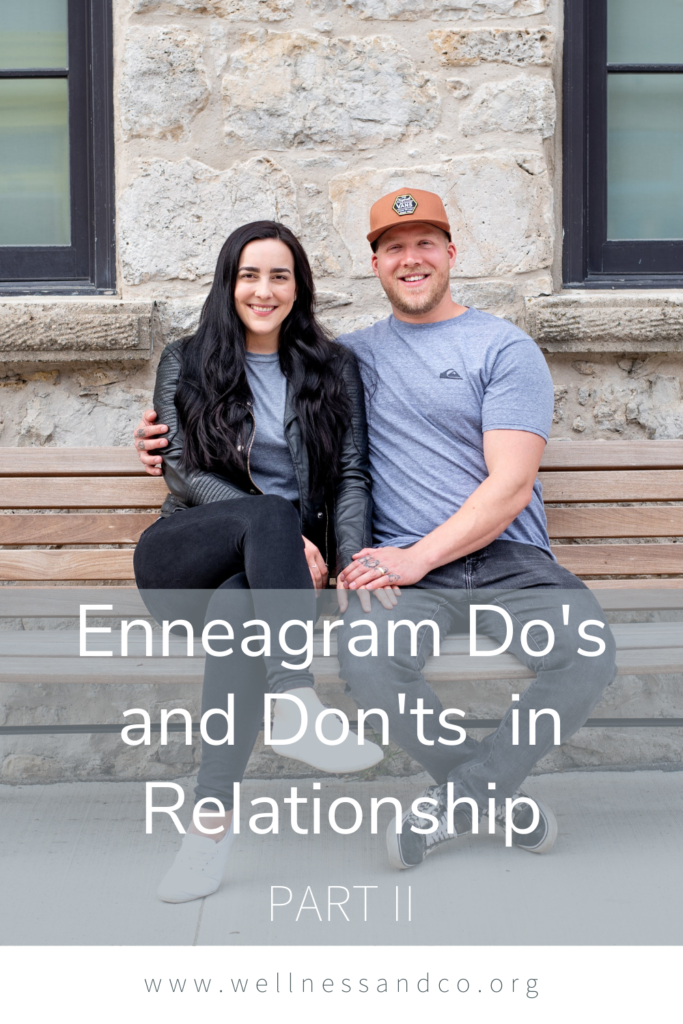Follow
Wellness & Co.
Hi, I'm Dr. K, Wellness & Co. is a growing therapy/coaching practice and educational hub for prospective clients based in Maryland and virtual clients all over the world!
Hi, I'm Dr. K
free guide
e -books
e -course
Enneagram Do’s and Don’ts in Relationship: Part II
November 13, 2020
by Amanda & Dylan, Relationship Coaches, Enneagram Teachers
Back again with part II of our Enneagram Do’s and Don’ts in Relationship. Check out our first post to lay the groundwork for our first, and super important, do/don’t:
- DON’T weaponize
- DO have a sense of humor
We have two more do’s/don’ts when it comes to the Enneagram in Relationship. Then, later this month we’re diving into our 3-step conflict resolution process and breaking through the resistance to change – stay tuned!

You’ll hear often how the Enneagram takes us out of the proverbial box we have put ourselves in, and this is completely true. So what we don’t want to do is assume that you know why someone is doing what they’re doing based on their Type – this is what makes them feel boxed in and undoes all of the work that the Enneagram has been doing to free us.
2. Don’t fill in the blank / Do get curious
The second layer to the filling in the blank is the realization that the way you are is not the way your partner is (even if y’all are the same Type).
This is one of the first things that couples discover in sessions – that they do not think, feel, act, process, and perceive life the same way as their counterpart. And it is in these differences that we can access the great gifts of our Type, our partners reflect back to us the hidden opportunities we have in ourselves.
The Enneagram, and couples work in general, is about self-discovery, and discovery happens through exploring what is really true for us.
Assumptions (while potentially positive in intent) often don’t bring us closer together. Assumptions come from our perception of reality, and the Enneagram is the perceptual lens that we view life through – so we are often filling in the blanks with our Type’s response.
One of the simplest and most profound ways to create deeper connection and cultivate a stronger bond is to get comfortable having conversations about what is showing up for us.
These open dialogues are necessary to get your needs met and to feel emotionally supported.
This means asking questions, engaging in honest conversation, and holding space for each other.
Examples of filling in the blank:
“S/he meant _____”
“S/he feels ______”
“S/he thinks ______”
“S/he needs _____”
Examples of getting curious:
“What did you mean when you said that?”
“How do you feel?”
“What do you think?”
“What do you need?”
Sounds simple, and it’s because it is.
Remember: Asking over assuming, always.
Big love,
Amanda & Dylan
Up Next: Do/Don’t Number Three!
Dylan is passionate about guiding teens, individuals and couples along the journey of looking within so they can find safety and courage in themselves and each other. He uses the enneagram (a very practical and tangible tool) to bring a deeper understanding to what it means to have self-love, and how to be fully present to your human experiences and relationships.
Leave a Reply Cancel reply
CONTACT
Start Here
BLOG
OUR TEAM
SHOP
ABOUT
©2025 Wellness & Co. | All Rights Reserved | Design by EverMint Design Studio
BACK TO TOP
connect with us on instagram
